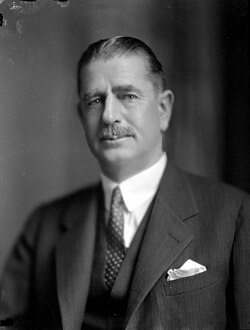Top Qs
Timeline
Chat
Perspective
1931 New Zealand general election
From Wikipedia, the free encyclopedia
Remove ads
The 1931 New Zealand general election was a nationwide vote to determine the shape of the New Zealand Parliament's 24th term. It resulted in the newly formed coalition between the United Party and the Reform Party remaining in office as the United–Reform Coalition Government, although the opposition Labour Party made some minor gains despite tallying more votes than any other single party.
Remove ads
Background
In the 1928 election, the Reform Party won 28 seats to the United Party's 27 seats. Shortly after the election the Reform Party lost a vote of no-confidence and the United Party managed to form a government, the United Government, with the support of the Labour Party, with governing Reform Party going into the opposition. In 1931, however, the agreement between United and Labour collapsed due to differing opinions on how to counter the Great Depression. The Reform Party, fearing that the Depression would give Labour a substantial boost, reluctantly agreed to form a coalition with United to avert elections. By forming a coalition, United and Reform were able to blunt Labour's advantage, ending the possibility of the anti-Labour vote being split.
Remove ads
The election
The date for the main 1931 elections was 2 December, a Wednesday. Elections to the four Māori electorates were held the day before. 874,787 people were registered to vote, and there was a turnout of 83.3%. This turnout was below average for the time period.
The number of seats was 80, a number which had been fixed since 1902.[1] However, in four electorates (Bay of Plenty, Oroua, Pahiatua, Waitomo) there was only one candidate.[2][3]
Remove ads
Results
Summarize
Perspective

The 1931 election saw the recently formed governing coalition retain office as the United–Reform Coalition, winning fifty-one seats, including four independents. This was a drop of four seats from what the two parties had won in the previous elections, but was still considerably better than many had expected given the economic situation. The Labour Party won twenty-four seats, a gain of five. In the popular vote (including pro-coalition independents), the coalition won 54.0% of the vote, down from the 66.1% that the two parties had won previously. Labour won 34.3%. The only other party to gain a place in Parliament was the Country Party, which won a single seat. Four other independents were elected. Four candidates were elected unopposed: Walter Broadfoot in Waitomo, John Cobbe in Oroua, Alfred Ransom in Pahiatua, and Kenneth Williams in Bay of Plenty.[4]
Party totals

Votes summary
The following table shows the detailed results:
Key
Reform Labour United Country Party Independent Liberal Ratana Independent
Table footnotes:
- For some biographical details of James Kerr refer to his father's article
- For some biographical details of McLachlan refer to his grandfather's article
- McMillan claimed to stand for the Reform Party, but he was not the official candidate, as the United–Reform Coalition endorsed William Polson, who ran as an Independent[27]
- Bill Sullivan was a member of the United Party, but Charles Macmillan was the official candidate of the United–Reform Coalition, hence Sullivan stood as an Independent
- Ziman was the father of John Ziman[30]
- Jull was the official candidate of the United–Reform Coalition
- Ormond was the son of John Davies Ormond and the father of John Ormond
- Four of the eight independent MPs (Connolly, Hargest, McSkimming, and Polson) were aligned with the United–Reform Coalition, and are not classified as independents by some sources.
Remove ads
Notes
References
Wikiwand - on
Seamless Wikipedia browsing. On steroids.
Remove ads






